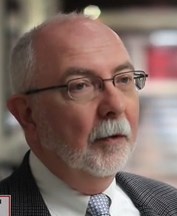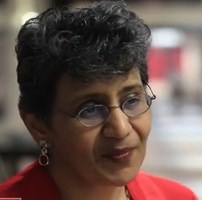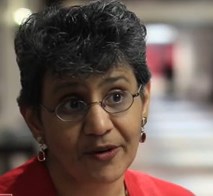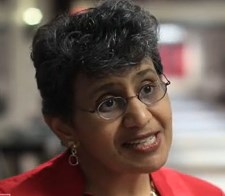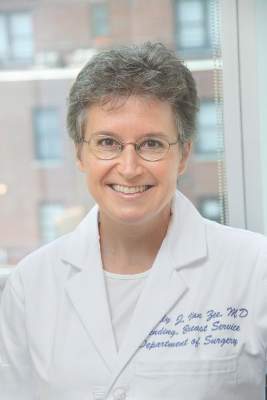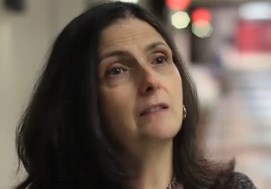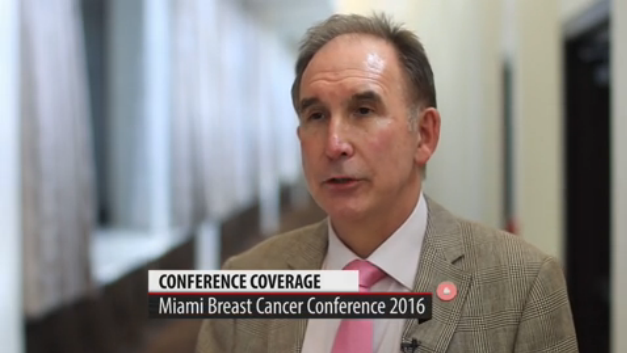User login
VIDEO: Treat most older women with stage I breast cancer with lumpectomy only
MIAMI – The trend over time to use less invasive surgery for breast cancer – from radical mastectomy to radical modified mastectomy to simplified mastectomy to lumpectomy – should extend now radiation therapy in older women with stage I disease, “and not give it unless it’s absolutely needed,” Dr. Kevin Hughes said at the annual Miami Breast Cancer Conference, held by Physicians’ Education Resource.
In fact, in most instances, these older women should receive lumpectomy without radiation, said Dr. Hughes of Massachusetts General Hospital and Harvard Medical School in Boston.
Three major trials that looked at stage I cancer in women over 50, 65, or 70 years of age reached the same conclusion: that radiation adds little benefit to overall treatment.
Dr. Hughes also said oncologists with genomic information on a specific cancer can also choose to more judiciously order radiation treatment, particularly with luminal A and, possibly, luminal B cancers.
Dr. Hughes had no relevant financial disclosures.
The video associated with this article is no longer available on this site. Please view all of our videos on the MDedge YouTube channel
MIAMI – The trend over time to use less invasive surgery for breast cancer – from radical mastectomy to radical modified mastectomy to simplified mastectomy to lumpectomy – should extend now radiation therapy in older women with stage I disease, “and not give it unless it’s absolutely needed,” Dr. Kevin Hughes said at the annual Miami Breast Cancer Conference, held by Physicians’ Education Resource.
In fact, in most instances, these older women should receive lumpectomy without radiation, said Dr. Hughes of Massachusetts General Hospital and Harvard Medical School in Boston.
Three major trials that looked at stage I cancer in women over 50, 65, or 70 years of age reached the same conclusion: that radiation adds little benefit to overall treatment.
Dr. Hughes also said oncologists with genomic information on a specific cancer can also choose to more judiciously order radiation treatment, particularly with luminal A and, possibly, luminal B cancers.
Dr. Hughes had no relevant financial disclosures.
The video associated with this article is no longer available on this site. Please view all of our videos on the MDedge YouTube channel
MIAMI – The trend over time to use less invasive surgery for breast cancer – from radical mastectomy to radical modified mastectomy to simplified mastectomy to lumpectomy – should extend now radiation therapy in older women with stage I disease, “and not give it unless it’s absolutely needed,” Dr. Kevin Hughes said at the annual Miami Breast Cancer Conference, held by Physicians’ Education Resource.
In fact, in most instances, these older women should receive lumpectomy without radiation, said Dr. Hughes of Massachusetts General Hospital and Harvard Medical School in Boston.
Three major trials that looked at stage I cancer in women over 50, 65, or 70 years of age reached the same conclusion: that radiation adds little benefit to overall treatment.
Dr. Hughes also said oncologists with genomic information on a specific cancer can also choose to more judiciously order radiation treatment, particularly with luminal A and, possibly, luminal B cancers.
Dr. Hughes had no relevant financial disclosures.
The video associated with this article is no longer available on this site. Please view all of our videos on the MDedge YouTube channel
EXPERT ANALYSIS FROM MBCC
VIDEO: Weighing the cost-effectiveness of contralateral risk-reducing mastectomy
MIAMI – Some researchers suggest contralateral prophylactic mastectomy increases costs, compared with a less-extensive ipsilateral procedure. But if true, the additional cost of the surgery needs to be couched within patient concerns about survival, Dr. Anees Chagpar said at the annual Miami Breast Cancer Conference, held by Physicians’ Education Resource.
The cost-effectiveness can vary based on patient age. In addition, there are costs associated with not undergoing a prophylactic mastectomy that are often not considered, added Dr. Chagpar, director of the Breast Center, Smilow Cancer Hospital at Yale-New Haven (Conn.).
Dr. Chagpar reported no relevant financial disclosures.
The video associated with this article is no longer available on this site. Please view all of our videos on the MDedge YouTube channel
MIAMI – Some researchers suggest contralateral prophylactic mastectomy increases costs, compared with a less-extensive ipsilateral procedure. But if true, the additional cost of the surgery needs to be couched within patient concerns about survival, Dr. Anees Chagpar said at the annual Miami Breast Cancer Conference, held by Physicians’ Education Resource.
The cost-effectiveness can vary based on patient age. In addition, there are costs associated with not undergoing a prophylactic mastectomy that are often not considered, added Dr. Chagpar, director of the Breast Center, Smilow Cancer Hospital at Yale-New Haven (Conn.).
Dr. Chagpar reported no relevant financial disclosures.
The video associated with this article is no longer available on this site. Please view all of our videos on the MDedge YouTube channel
MIAMI – Some researchers suggest contralateral prophylactic mastectomy increases costs, compared with a less-extensive ipsilateral procedure. But if true, the additional cost of the surgery needs to be couched within patient concerns about survival, Dr. Anees Chagpar said at the annual Miami Breast Cancer Conference, held by Physicians’ Education Resource.
The cost-effectiveness can vary based on patient age. In addition, there are costs associated with not undergoing a prophylactic mastectomy that are often not considered, added Dr. Chagpar, director of the Breast Center, Smilow Cancer Hospital at Yale-New Haven (Conn.).
Dr. Chagpar reported no relevant financial disclosures.
The video associated with this article is no longer available on this site. Please view all of our videos on the MDedge YouTube channel
EXPERT ANALYSIS FROM MBCC
VIDEO: Carefully consider impact of MRI to detect contralateral breast cancer
MIAMI – Physicians generally herald advances in medical imaging technology to improve and inform clinical decision-making for their patients. However, greater precision in MRI findings can leave physicians wondering how to advise patients concerned about a contralateral breast cancer, Dr. Anees Chagpar said.
It boils down to clinical significance and anxiety. Smaller lesions now detected by MRI may or may not indicate a true increase in risk, Dr. Chagpar said at the annual Miami Breast Cancer Conference, held by Physicians’ Education Resource. In addition, evidence suggests just having an MRI raises anxiety in some women with unilateral breast cancer, regardless of results. She advises providers to carefully consider why they’re ordering an MRI and the potential impact on a patient already at a heightened state of anxiety from their initial diagnosis.
Dr. Chagpar, director of the Breast Center, Smilow Cancer Hospital at Yale-New Haven (Conn.), reported no relevant financial disclosures.
The video associated with this article is no longer available on this site. Please view all of our videos on the MDedge YouTube channel
MIAMI – Physicians generally herald advances in medical imaging technology to improve and inform clinical decision-making for their patients. However, greater precision in MRI findings can leave physicians wondering how to advise patients concerned about a contralateral breast cancer, Dr. Anees Chagpar said.
It boils down to clinical significance and anxiety. Smaller lesions now detected by MRI may or may not indicate a true increase in risk, Dr. Chagpar said at the annual Miami Breast Cancer Conference, held by Physicians’ Education Resource. In addition, evidence suggests just having an MRI raises anxiety in some women with unilateral breast cancer, regardless of results. She advises providers to carefully consider why they’re ordering an MRI and the potential impact on a patient already at a heightened state of anxiety from their initial diagnosis.
Dr. Chagpar, director of the Breast Center, Smilow Cancer Hospital at Yale-New Haven (Conn.), reported no relevant financial disclosures.
The video associated with this article is no longer available on this site. Please view all of our videos on the MDedge YouTube channel
MIAMI – Physicians generally herald advances in medical imaging technology to improve and inform clinical decision-making for their patients. However, greater precision in MRI findings can leave physicians wondering how to advise patients concerned about a contralateral breast cancer, Dr. Anees Chagpar said.
It boils down to clinical significance and anxiety. Smaller lesions now detected by MRI may or may not indicate a true increase in risk, Dr. Chagpar said at the annual Miami Breast Cancer Conference, held by Physicians’ Education Resource. In addition, evidence suggests just having an MRI raises anxiety in some women with unilateral breast cancer, regardless of results. She advises providers to carefully consider why they’re ordering an MRI and the potential impact on a patient already at a heightened state of anxiety from their initial diagnosis.
Dr. Chagpar, director of the Breast Center, Smilow Cancer Hospital at Yale-New Haven (Conn.), reported no relevant financial disclosures.
The video associated with this article is no longer available on this site. Please view all of our videos on the MDedge YouTube channel
EXPERT ANALYSIS AT MBCC
VIDEO: Counseling patients considering contralateral prophylactic mastectomy
MIAMI – The number of women with ipsilateral breast cancer seeking a contralateral mastectomy to reduce their future risk and, essentially, for peace of mind, is increasing. Dr. Anees Chagpar director of the Breast Center, Smilow Cancer Hospital at Yale-New Haven (Conn.), suggests what doctors can include in discussions with these patients.
Presenting patients with a complete picture of risks and benefits promotes shared decision-making. Consider the absolute risk reduction provided by this type of surgery, particularly in older patients who are not BRCA 1 or 2 carriers, Dr. Chagpar said at the annual Miami Breast Cancer Conference, held by Physicians’ Education Resource.
Differences between unilateral and bilateral surgery go beyond operative time, duration of hospital stay, and risk of complications, Dr. Chagpar said, and should include a discussion about patient values and what is driving their consideration of this surgery.
Dr. Chagpar had no relevant financial disclosures.
The video associated with this article is no longer available on this site. Please view all of our videos on the MDedge YouTube channel
MIAMI – The number of women with ipsilateral breast cancer seeking a contralateral mastectomy to reduce their future risk and, essentially, for peace of mind, is increasing. Dr. Anees Chagpar director of the Breast Center, Smilow Cancer Hospital at Yale-New Haven (Conn.), suggests what doctors can include in discussions with these patients.
Presenting patients with a complete picture of risks and benefits promotes shared decision-making. Consider the absolute risk reduction provided by this type of surgery, particularly in older patients who are not BRCA 1 or 2 carriers, Dr. Chagpar said at the annual Miami Breast Cancer Conference, held by Physicians’ Education Resource.
Differences between unilateral and bilateral surgery go beyond operative time, duration of hospital stay, and risk of complications, Dr. Chagpar said, and should include a discussion about patient values and what is driving their consideration of this surgery.
Dr. Chagpar had no relevant financial disclosures.
The video associated with this article is no longer available on this site. Please view all of our videos on the MDedge YouTube channel
MIAMI – The number of women with ipsilateral breast cancer seeking a contralateral mastectomy to reduce their future risk and, essentially, for peace of mind, is increasing. Dr. Anees Chagpar director of the Breast Center, Smilow Cancer Hospital at Yale-New Haven (Conn.), suggests what doctors can include in discussions with these patients.
Presenting patients with a complete picture of risks and benefits promotes shared decision-making. Consider the absolute risk reduction provided by this type of surgery, particularly in older patients who are not BRCA 1 or 2 carriers, Dr. Chagpar said at the annual Miami Breast Cancer Conference, held by Physicians’ Education Resource.
Differences between unilateral and bilateral surgery go beyond operative time, duration of hospital stay, and risk of complications, Dr. Chagpar said, and should include a discussion about patient values and what is driving their consideration of this surgery.
Dr. Chagpar had no relevant financial disclosures.
The video associated with this article is no longer available on this site. Please view all of our videos on the MDedge YouTube channel
EXPERT ANALYSIS FROM MBCC
Review: Use wider margins for DCIS surgery without radiotherapy
MIAMI – A wider margin width for women undergoing breast-conserving surgery without radiotherapy for ductal carcinoma in situ (DCIS) may be better for women than the 2-mm or greater margin width for women undergoing radiotherapy that was recently recommended in a draft consensus statement.
The draft consensus statement is currently under review by the Society of Surgical Oncology, the American Society for Radiation Oncology, the American Society of Clinical Oncology, and the American Society of Breast Surgeons, Dr. Kimberly Van Zee, who participated in the November consensus conference, reported at the annual Miami Breast Cancer Conference, held by the Physicians’ Education Resource.
The draft consensus statement does not address margin width in those who are not receiving radiotherapy because data are lacking in that population, but in her own retrospective review of nearly 3,000 cases, Dr. Van Zee found that “wider margin width is associated with a lower risk of recurrence among women not undergoing radiation.”
Her review, published in October (Ann Surg. 2015;262:623-31) and considered in the development of the draft consensus statement, included 2,996 consecutive women who underwent breast conserving surgery between 1978 and 2010. Of those, 363 experienced recurrence; 732 of the women were followed for at least 10 years, and the median follow-up period was 75 months, said Dr. Van Zee, a surgical oncologist at Memorial Sloan Kettering Cancer Center, New York.
After controlling for age, family history, clinical vs. radiologic presentation, nuclear grade, number of excisions, radiotherapy, endocrine therapy, and year of surgery, margin width was shown to be significantly associated with recurrence, she noted.
Women with larger negative margins had a significantly lower risk of recurrence vs. those with positive margins, she said.
An interaction between radiation therapy and margin width was significant, which indicates that the effect of margin width differs by use of radiation therapy, she noted.
Stratification by radiation therapy use demonstrated that the association of recurrence with margin width was significant in those not receiving radiation therapy, but not in those receiving radiation therapy.
Among those not receiving radiation therapy, a margin width of greater than 10 mm was associated with about a 60% reduction in recurrence, compared with those with negative margins of 2 mm or less.
The findings are important, because while DCIS has minimal mortality, recurrence rates after breast-conserving surgery are significant, and about half of recurrences are invasive, she explained.
“We know that negative margins are clearly a factor that’s associated with a lower risk of recurrence; the problem with all of our randomized trials and many retrospective studies is that margins have been categorized as positive or negative, so that doesn’t help us in determining what the optimal negative margin is,” she said.
Importantly, while radiation is known to reduce the rate of recurrence, that reduction is proportional.
“In every subset, radiation reduces risk by about half,” she said, noting that in patients with low risk, a 50% reduction may not be worth it.
Conference chair Dr. Patrick I. Borgen of Maimonides Medical Center in Brooklyn, N.Y., praised Dr. Van Zee’s work, saying that “without any question, that review will significantly impact the meta-analysis as we go forward and try to make some sense of what to do with our patients with DCIS.”
Dr. Van Zee reported having no disclosures. Dr. Borgen is on speakers bureaus for Genomic Health and NanoString Technologies.
MIAMI – A wider margin width for women undergoing breast-conserving surgery without radiotherapy for ductal carcinoma in situ (DCIS) may be better for women than the 2-mm or greater margin width for women undergoing radiotherapy that was recently recommended in a draft consensus statement.
The draft consensus statement is currently under review by the Society of Surgical Oncology, the American Society for Radiation Oncology, the American Society of Clinical Oncology, and the American Society of Breast Surgeons, Dr. Kimberly Van Zee, who participated in the November consensus conference, reported at the annual Miami Breast Cancer Conference, held by the Physicians’ Education Resource.
The draft consensus statement does not address margin width in those who are not receiving radiotherapy because data are lacking in that population, but in her own retrospective review of nearly 3,000 cases, Dr. Van Zee found that “wider margin width is associated with a lower risk of recurrence among women not undergoing radiation.”
Her review, published in October (Ann Surg. 2015;262:623-31) and considered in the development of the draft consensus statement, included 2,996 consecutive women who underwent breast conserving surgery between 1978 and 2010. Of those, 363 experienced recurrence; 732 of the women were followed for at least 10 years, and the median follow-up period was 75 months, said Dr. Van Zee, a surgical oncologist at Memorial Sloan Kettering Cancer Center, New York.
After controlling for age, family history, clinical vs. radiologic presentation, nuclear grade, number of excisions, radiotherapy, endocrine therapy, and year of surgery, margin width was shown to be significantly associated with recurrence, she noted.
Women with larger negative margins had a significantly lower risk of recurrence vs. those with positive margins, she said.
An interaction between radiation therapy and margin width was significant, which indicates that the effect of margin width differs by use of radiation therapy, she noted.
Stratification by radiation therapy use demonstrated that the association of recurrence with margin width was significant in those not receiving radiation therapy, but not in those receiving radiation therapy.
Among those not receiving radiation therapy, a margin width of greater than 10 mm was associated with about a 60% reduction in recurrence, compared with those with negative margins of 2 mm or less.
The findings are important, because while DCIS has minimal mortality, recurrence rates after breast-conserving surgery are significant, and about half of recurrences are invasive, she explained.
“We know that negative margins are clearly a factor that’s associated with a lower risk of recurrence; the problem with all of our randomized trials and many retrospective studies is that margins have been categorized as positive or negative, so that doesn’t help us in determining what the optimal negative margin is,” she said.
Importantly, while radiation is known to reduce the rate of recurrence, that reduction is proportional.
“In every subset, radiation reduces risk by about half,” she said, noting that in patients with low risk, a 50% reduction may not be worth it.
Conference chair Dr. Patrick I. Borgen of Maimonides Medical Center in Brooklyn, N.Y., praised Dr. Van Zee’s work, saying that “without any question, that review will significantly impact the meta-analysis as we go forward and try to make some sense of what to do with our patients with DCIS.”
Dr. Van Zee reported having no disclosures. Dr. Borgen is on speakers bureaus for Genomic Health and NanoString Technologies.
MIAMI – A wider margin width for women undergoing breast-conserving surgery without radiotherapy for ductal carcinoma in situ (DCIS) may be better for women than the 2-mm or greater margin width for women undergoing radiotherapy that was recently recommended in a draft consensus statement.
The draft consensus statement is currently under review by the Society of Surgical Oncology, the American Society for Radiation Oncology, the American Society of Clinical Oncology, and the American Society of Breast Surgeons, Dr. Kimberly Van Zee, who participated in the November consensus conference, reported at the annual Miami Breast Cancer Conference, held by the Physicians’ Education Resource.
The draft consensus statement does not address margin width in those who are not receiving radiotherapy because data are lacking in that population, but in her own retrospective review of nearly 3,000 cases, Dr. Van Zee found that “wider margin width is associated with a lower risk of recurrence among women not undergoing radiation.”
Her review, published in October (Ann Surg. 2015;262:623-31) and considered in the development of the draft consensus statement, included 2,996 consecutive women who underwent breast conserving surgery between 1978 and 2010. Of those, 363 experienced recurrence; 732 of the women were followed for at least 10 years, and the median follow-up period was 75 months, said Dr. Van Zee, a surgical oncologist at Memorial Sloan Kettering Cancer Center, New York.
After controlling for age, family history, clinical vs. radiologic presentation, nuclear grade, number of excisions, radiotherapy, endocrine therapy, and year of surgery, margin width was shown to be significantly associated with recurrence, she noted.
Women with larger negative margins had a significantly lower risk of recurrence vs. those with positive margins, she said.
An interaction between radiation therapy and margin width was significant, which indicates that the effect of margin width differs by use of radiation therapy, she noted.
Stratification by radiation therapy use demonstrated that the association of recurrence with margin width was significant in those not receiving radiation therapy, but not in those receiving radiation therapy.
Among those not receiving radiation therapy, a margin width of greater than 10 mm was associated with about a 60% reduction in recurrence, compared with those with negative margins of 2 mm or less.
The findings are important, because while DCIS has minimal mortality, recurrence rates after breast-conserving surgery are significant, and about half of recurrences are invasive, she explained.
“We know that negative margins are clearly a factor that’s associated with a lower risk of recurrence; the problem with all of our randomized trials and many retrospective studies is that margins have been categorized as positive or negative, so that doesn’t help us in determining what the optimal negative margin is,” she said.
Importantly, while radiation is known to reduce the rate of recurrence, that reduction is proportional.
“In every subset, radiation reduces risk by about half,” she said, noting that in patients with low risk, a 50% reduction may not be worth it.
Conference chair Dr. Patrick I. Borgen of Maimonides Medical Center in Brooklyn, N.Y., praised Dr. Van Zee’s work, saying that “without any question, that review will significantly impact the meta-analysis as we go forward and try to make some sense of what to do with our patients with DCIS.”
Dr. Van Zee reported having no disclosures. Dr. Borgen is on speakers bureaus for Genomic Health and NanoString Technologies.
AT MBCC
Key clinical point: A 2-mm or greater margin is optimal in women undergoing breast-conserving surgery and radiotherapy for ductal carcinoma in situ, according to the conclusion of a recent consensus conference, but wider margins may be needed in the absence of radiotherapy.
Major finding: Among those not receiving radiation therapy, a margin width of greater than 10 mm was associated with about a 60% reduction in recurrence, compared with those with negative margins of 2 mm or less.
Data source: A retrospective review of 2,996 cases
Disclosures: Dr. Van Zee reported having no disclosures. Dr. Borgen is on speakers bureaus for Genomic Health and NanoString Technologies.
VIDEO: Breast cancer surgery choice depends on the individual
MIAMI – In addition to a thorough discussion of the risks and benefits of breast-conserving therapy and mastectomy, physicians need to address the individual concerns that each patient will have before choosing a procedure, Dr. Patrick Borgen, chair of the department of surgery at Maimonides Medical Center in Brooklyn, N.Y., said.
The facts do not support the superiority of one procedure over another for all women, Dr. Borgen said at the annual Miami Breast Cancer Conference, held by Physicians’ Education Resource. When discussing the options, each individual patient will have unique concerns and quality of life issues that need to be factored into a collaborative decision about the choice of procedure.
Not including mastectomy in the conversation could be a disservice to the patient, Dr. Borgen said. Quality of life over time, patient anxiety, and “the price of vigilance” are additional factors that patients consider when weighing their surgical options.
Dr. Borgen had no relevant financial disclosures.
The video associated with this article is no longer available on this site. Please view all of our videos on the MDedge YouTube channel
MIAMI – In addition to a thorough discussion of the risks and benefits of breast-conserving therapy and mastectomy, physicians need to address the individual concerns that each patient will have before choosing a procedure, Dr. Patrick Borgen, chair of the department of surgery at Maimonides Medical Center in Brooklyn, N.Y., said.
The facts do not support the superiority of one procedure over another for all women, Dr. Borgen said at the annual Miami Breast Cancer Conference, held by Physicians’ Education Resource. When discussing the options, each individual patient will have unique concerns and quality of life issues that need to be factored into a collaborative decision about the choice of procedure.
Not including mastectomy in the conversation could be a disservice to the patient, Dr. Borgen said. Quality of life over time, patient anxiety, and “the price of vigilance” are additional factors that patients consider when weighing their surgical options.
Dr. Borgen had no relevant financial disclosures.
The video associated with this article is no longer available on this site. Please view all of our videos on the MDedge YouTube channel
MIAMI – In addition to a thorough discussion of the risks and benefits of breast-conserving therapy and mastectomy, physicians need to address the individual concerns that each patient will have before choosing a procedure, Dr. Patrick Borgen, chair of the department of surgery at Maimonides Medical Center in Brooklyn, N.Y., said.
The facts do not support the superiority of one procedure over another for all women, Dr. Borgen said at the annual Miami Breast Cancer Conference, held by Physicians’ Education Resource. When discussing the options, each individual patient will have unique concerns and quality of life issues that need to be factored into a collaborative decision about the choice of procedure.
Not including mastectomy in the conversation could be a disservice to the patient, Dr. Borgen said. Quality of life over time, patient anxiety, and “the price of vigilance” are additional factors that patients consider when weighing their surgical options.
Dr. Borgen had no relevant financial disclosures.
The video associated with this article is no longer available on this site. Please view all of our videos on the MDedge YouTube channel
AT MBCC
VIDEO: Advice varies for chemoprevention, genetic testing in invasive breast cancer
MIAMI – The message from major trials evaluating tamoxifen, raloxifene, and aromatase inhibitors for chemoprevention of invasive breast cancer got clearer with data from extended follow-up coming in. Interestingly, sometimes the longer duration studies confirm earlier findings, and sometimes they do not – and researchers end up reaching new conclusions, Dr. Banu Arun of the University of Texas MD Anderson Cancer Center in Houston explained at the annual Miami Breast Cancer Conference, held by Physicians’ Education Resource.
Although not everyone agrees, Dr. Arun said why she believes there is still a role for chemoprevention of invasive breast cancer. In cases where studies do not point to a clear-cut difference in survival outcomes between agents, she recommends physicians select therapy based on other risks, benefits, and other considerations.
Technology also presents a challenge. Advances in next generation sequencing, for example, allow physicians to order a test for up to 25 genetic mutations associated with breast cancer. Compared with earlier assays that only tested for well-known risk factors like BRCA 1 and BRCA 2, these panels can return results where the clinical implications remain uncertain, leaving doctors unclear on how to counsel patients.
Dr. Arun had no relevant financial disclosures.
The video associated with this article is no longer available on this site. Please view all of our videos on the MDedge YouTube channel
MIAMI – The message from major trials evaluating tamoxifen, raloxifene, and aromatase inhibitors for chemoprevention of invasive breast cancer got clearer with data from extended follow-up coming in. Interestingly, sometimes the longer duration studies confirm earlier findings, and sometimes they do not – and researchers end up reaching new conclusions, Dr. Banu Arun of the University of Texas MD Anderson Cancer Center in Houston explained at the annual Miami Breast Cancer Conference, held by Physicians’ Education Resource.
Although not everyone agrees, Dr. Arun said why she believes there is still a role for chemoprevention of invasive breast cancer. In cases where studies do not point to a clear-cut difference in survival outcomes between agents, she recommends physicians select therapy based on other risks, benefits, and other considerations.
Technology also presents a challenge. Advances in next generation sequencing, for example, allow physicians to order a test for up to 25 genetic mutations associated with breast cancer. Compared with earlier assays that only tested for well-known risk factors like BRCA 1 and BRCA 2, these panels can return results where the clinical implications remain uncertain, leaving doctors unclear on how to counsel patients.
Dr. Arun had no relevant financial disclosures.
The video associated with this article is no longer available on this site. Please view all of our videos on the MDedge YouTube channel
MIAMI – The message from major trials evaluating tamoxifen, raloxifene, and aromatase inhibitors for chemoprevention of invasive breast cancer got clearer with data from extended follow-up coming in. Interestingly, sometimes the longer duration studies confirm earlier findings, and sometimes they do not – and researchers end up reaching new conclusions, Dr. Banu Arun of the University of Texas MD Anderson Cancer Center in Houston explained at the annual Miami Breast Cancer Conference, held by Physicians’ Education Resource.
Although not everyone agrees, Dr. Arun said why she believes there is still a role for chemoprevention of invasive breast cancer. In cases where studies do not point to a clear-cut difference in survival outcomes between agents, she recommends physicians select therapy based on other risks, benefits, and other considerations.
Technology also presents a challenge. Advances in next generation sequencing, for example, allow physicians to order a test for up to 25 genetic mutations associated with breast cancer. Compared with earlier assays that only tested for well-known risk factors like BRCA 1 and BRCA 2, these panels can return results where the clinical implications remain uncertain, leaving doctors unclear on how to counsel patients.
Dr. Arun had no relevant financial disclosures.
The video associated with this article is no longer available on this site. Please view all of our videos on the MDedge YouTube channel
EXPERT ANALYSIS FROM MBCC
Breast cancer vaccines hold promise
MIAMI BEACH – Vaccines are an appealing therapeutic strategy for cancer because they are specific and have minimal associated toxicity, according to Dr. Elizabeth A. Mittendorf.
Further, they stimulate the adaptive immune system, thereby eliciting a memory response that allows for sustained effect, she said at the annual Miami Breast Cancer Conference, held by Physicians’ Education Resource.
For these reasons, there is a great deal of interest in the possibility of a breast cancer vaccine, she said.
No such vaccine has been approved, but several vaccines, as well as treatment strategies employing the investigational vaccines, are currently in clinical trials, she said.
One – E75 (nelipepimut-S) – is being evaluated in the ongoing PRESENT (Prevention of Recurrence in Early Stage Node-Positive Breast Cancers with Low to Intermediate HER2 Expression with NeuVax Treatment) phase III registration trial.
“E75 is a 9-amino-acid peptide in the protein’s extracellular domain. It’s what’s referred to as an immunodominant epitope of HER2; that simply means it’s the one that’s presented best and therefore [is] recognized most efficiently by the immune system. It’s a major histocompatibility complex (MHC) class I peptide, which means it’s going to stimulate a CD8+ T-cell response,” she explained, adding that E75 has “a high affinity for HLA-A2 and -A3, meaning that patients with those haplotypes are the ones most likely to benefit from vaccination.”
For the phase I and II trials, E75 was combined with granulocyte-macrophage colony-stimulating factor (GM-CSF). This “very simple vaccine strategy” was administered to prevent disease recurrence in patients with high-risk breast cancer.
“We’re vaccinating patients who have been rendered disease free with standard of care therapy to include surgery, chemotherapy, and, when indicated, radiation, with the goal being to prevent disease recurrence,” she said, noting that all patients had histologically confirmed breast cancer and were either node positive or high-risk node negative.
The original primary endpoint of the study was disease-free survival at 18 months, but encouraging data led to an extension of that out to 5 years.
A combined analysis of the phase I and II trials included 187 evaluable patients, who had an overall 90% rate of 5-year disease-free survival, compared with 80% among controls. The difference, which represented about a 50% relative risk reduction was statistically significant, Dr. Mittendorf said.
Among patients who received optimal dosing, the 5-year disease-free survival rate was 95%, she added.
E75 has now been licensed and the E75-GM-CSF combination is known as NeuVax. For the PRESENT III trial, the treatment is administered in the adjuvant setting in node-positive HLA-A2 and -A3 patients with low or intermediate HER2-expressing tumors.
Patients were randomized to receive six shots monthly for 6 months of either the combination or GM-CSF alone, followed by booster inoculations every 6 months for 3 years.
The trial has completed accrual and randomization, and includes 750 patients.
“The goal is to look at disease-free survival at 3 years, so the study should read out in the Spring of 2018,” she said.
In the meantime, efforts are underway to identify strategies – such as use of booster inoculations similar to those used in the PRESENT III trial – to augment response to vaccination, and to develop a multiepitope vaccine involving peptides that stimulate a different CD8+ T-cell response or CD4+ T-cell response.
“We’ve been very interested in the idea of the combination of immunotherapy with trastuzumab, and combination therapy with immunogenic chemo ... so based on the preclinical and scientific rationale, as well as the observation in our previous study, we’re moving forward now with a phase II trial looking at combination therapy with a class I vaccine in combination with trastuzumab in high-risk HER2-positive patients,” Dr. Mittendorf said.
Patients will be randomized to receive trastuzumab plus vaccine or trastuzumab alone, which is the current standard of care, and the primary end point is disease-free survival. The trial is currently enrolling patients and is about a third accrued.
Additional strategies being investigated include allogeneic vaccines, viral vaccines, and others, she said.
The use of vaccines for primary cancer prevention is also of great interest, Dr. Mittendorf said, noting that because of the success with E75, her group has been asked by the National Cancer Institute to conduct a trial in patients with ductal carcinoma in situ “as a first step toward moving into prevention.”
“About 2 weeks ago, we had the site initiation visits for the VADIS trial. This is a phase II trial of nelipepimut-S (E75, NeuVAX),” she said.
For that trial, patients with DCIS will be vaccinated with three doses before surgery, and with three in the postoperative period. The primary endpoint is the generation of E75-specific cytotoxic T lymphocytes; the study will also include a number of secondary endpoints, including epitope spreading.
Dr. Mittendorf predicted that the appropriate vaccine strategy will be dictated by disease stage.
“For the situation where we are trying to prevent the development of a cancer or for the situation where we’re administering the vaccine in the adjuvant setting as secondary prevention to prevent recurrence, the vaccine alone may be enough. However, for later-stage disease, it’s likely that we’ll need to use combination therapy,” she said.
Conference program chair Dr. Patrick I. Borgen of Maimonides Medical Center in Brooklyn said immunotherapy is one of the most exciting – and at times, most disappointing – fields within the breast cancer arena.
“In the last couple of years, we’ve seen – really for the first time – very, very, very significant strides being made in cancer immunology,” he said.
Dr. Mittendorf has received funding to her institution from Galena Biopharma and Antigen Express. She reported having no other disclosures. Dr. Borgen is a member of the speakers bureaus for Genomic Health and NanoString Technologies.
MIAMI BEACH – Vaccines are an appealing therapeutic strategy for cancer because they are specific and have minimal associated toxicity, according to Dr. Elizabeth A. Mittendorf.
Further, they stimulate the adaptive immune system, thereby eliciting a memory response that allows for sustained effect, she said at the annual Miami Breast Cancer Conference, held by Physicians’ Education Resource.
For these reasons, there is a great deal of interest in the possibility of a breast cancer vaccine, she said.
No such vaccine has been approved, but several vaccines, as well as treatment strategies employing the investigational vaccines, are currently in clinical trials, she said.
One – E75 (nelipepimut-S) – is being evaluated in the ongoing PRESENT (Prevention of Recurrence in Early Stage Node-Positive Breast Cancers with Low to Intermediate HER2 Expression with NeuVax Treatment) phase III registration trial.
“E75 is a 9-amino-acid peptide in the protein’s extracellular domain. It’s what’s referred to as an immunodominant epitope of HER2; that simply means it’s the one that’s presented best and therefore [is] recognized most efficiently by the immune system. It’s a major histocompatibility complex (MHC) class I peptide, which means it’s going to stimulate a CD8+ T-cell response,” she explained, adding that E75 has “a high affinity for HLA-A2 and -A3, meaning that patients with those haplotypes are the ones most likely to benefit from vaccination.”
For the phase I and II trials, E75 was combined with granulocyte-macrophage colony-stimulating factor (GM-CSF). This “very simple vaccine strategy” was administered to prevent disease recurrence in patients with high-risk breast cancer.
“We’re vaccinating patients who have been rendered disease free with standard of care therapy to include surgery, chemotherapy, and, when indicated, radiation, with the goal being to prevent disease recurrence,” she said, noting that all patients had histologically confirmed breast cancer and were either node positive or high-risk node negative.
The original primary endpoint of the study was disease-free survival at 18 months, but encouraging data led to an extension of that out to 5 years.
A combined analysis of the phase I and II trials included 187 evaluable patients, who had an overall 90% rate of 5-year disease-free survival, compared with 80% among controls. The difference, which represented about a 50% relative risk reduction was statistically significant, Dr. Mittendorf said.
Among patients who received optimal dosing, the 5-year disease-free survival rate was 95%, she added.
E75 has now been licensed and the E75-GM-CSF combination is known as NeuVax. For the PRESENT III trial, the treatment is administered in the adjuvant setting in node-positive HLA-A2 and -A3 patients with low or intermediate HER2-expressing tumors.
Patients were randomized to receive six shots monthly for 6 months of either the combination or GM-CSF alone, followed by booster inoculations every 6 months for 3 years.
The trial has completed accrual and randomization, and includes 750 patients.
“The goal is to look at disease-free survival at 3 years, so the study should read out in the Spring of 2018,” she said.
In the meantime, efforts are underway to identify strategies – such as use of booster inoculations similar to those used in the PRESENT III trial – to augment response to vaccination, and to develop a multiepitope vaccine involving peptides that stimulate a different CD8+ T-cell response or CD4+ T-cell response.
“We’ve been very interested in the idea of the combination of immunotherapy with trastuzumab, and combination therapy with immunogenic chemo ... so based on the preclinical and scientific rationale, as well as the observation in our previous study, we’re moving forward now with a phase II trial looking at combination therapy with a class I vaccine in combination with trastuzumab in high-risk HER2-positive patients,” Dr. Mittendorf said.
Patients will be randomized to receive trastuzumab plus vaccine or trastuzumab alone, which is the current standard of care, and the primary end point is disease-free survival. The trial is currently enrolling patients and is about a third accrued.
Additional strategies being investigated include allogeneic vaccines, viral vaccines, and others, she said.
The use of vaccines for primary cancer prevention is also of great interest, Dr. Mittendorf said, noting that because of the success with E75, her group has been asked by the National Cancer Institute to conduct a trial in patients with ductal carcinoma in situ “as a first step toward moving into prevention.”
“About 2 weeks ago, we had the site initiation visits for the VADIS trial. This is a phase II trial of nelipepimut-S (E75, NeuVAX),” she said.
For that trial, patients with DCIS will be vaccinated with three doses before surgery, and with three in the postoperative period. The primary endpoint is the generation of E75-specific cytotoxic T lymphocytes; the study will also include a number of secondary endpoints, including epitope spreading.
Dr. Mittendorf predicted that the appropriate vaccine strategy will be dictated by disease stage.
“For the situation where we are trying to prevent the development of a cancer or for the situation where we’re administering the vaccine in the adjuvant setting as secondary prevention to prevent recurrence, the vaccine alone may be enough. However, for later-stage disease, it’s likely that we’ll need to use combination therapy,” she said.
Conference program chair Dr. Patrick I. Borgen of Maimonides Medical Center in Brooklyn said immunotherapy is one of the most exciting – and at times, most disappointing – fields within the breast cancer arena.
“In the last couple of years, we’ve seen – really for the first time – very, very, very significant strides being made in cancer immunology,” he said.
Dr. Mittendorf has received funding to her institution from Galena Biopharma and Antigen Express. She reported having no other disclosures. Dr. Borgen is a member of the speakers bureaus for Genomic Health and NanoString Technologies.
MIAMI BEACH – Vaccines are an appealing therapeutic strategy for cancer because they are specific and have minimal associated toxicity, according to Dr. Elizabeth A. Mittendorf.
Further, they stimulate the adaptive immune system, thereby eliciting a memory response that allows for sustained effect, she said at the annual Miami Breast Cancer Conference, held by Physicians’ Education Resource.
For these reasons, there is a great deal of interest in the possibility of a breast cancer vaccine, she said.
No such vaccine has been approved, but several vaccines, as well as treatment strategies employing the investigational vaccines, are currently in clinical trials, she said.
One – E75 (nelipepimut-S) – is being evaluated in the ongoing PRESENT (Prevention of Recurrence in Early Stage Node-Positive Breast Cancers with Low to Intermediate HER2 Expression with NeuVax Treatment) phase III registration trial.
“E75 is a 9-amino-acid peptide in the protein’s extracellular domain. It’s what’s referred to as an immunodominant epitope of HER2; that simply means it’s the one that’s presented best and therefore [is] recognized most efficiently by the immune system. It’s a major histocompatibility complex (MHC) class I peptide, which means it’s going to stimulate a CD8+ T-cell response,” she explained, adding that E75 has “a high affinity for HLA-A2 and -A3, meaning that patients with those haplotypes are the ones most likely to benefit from vaccination.”
For the phase I and II trials, E75 was combined with granulocyte-macrophage colony-stimulating factor (GM-CSF). This “very simple vaccine strategy” was administered to prevent disease recurrence in patients with high-risk breast cancer.
“We’re vaccinating patients who have been rendered disease free with standard of care therapy to include surgery, chemotherapy, and, when indicated, radiation, with the goal being to prevent disease recurrence,” she said, noting that all patients had histologically confirmed breast cancer and were either node positive or high-risk node negative.
The original primary endpoint of the study was disease-free survival at 18 months, but encouraging data led to an extension of that out to 5 years.
A combined analysis of the phase I and II trials included 187 evaluable patients, who had an overall 90% rate of 5-year disease-free survival, compared with 80% among controls. The difference, which represented about a 50% relative risk reduction was statistically significant, Dr. Mittendorf said.
Among patients who received optimal dosing, the 5-year disease-free survival rate was 95%, she added.
E75 has now been licensed and the E75-GM-CSF combination is known as NeuVax. For the PRESENT III trial, the treatment is administered in the adjuvant setting in node-positive HLA-A2 and -A3 patients with low or intermediate HER2-expressing tumors.
Patients were randomized to receive six shots monthly for 6 months of either the combination or GM-CSF alone, followed by booster inoculations every 6 months for 3 years.
The trial has completed accrual and randomization, and includes 750 patients.
“The goal is to look at disease-free survival at 3 years, so the study should read out in the Spring of 2018,” she said.
In the meantime, efforts are underway to identify strategies – such as use of booster inoculations similar to those used in the PRESENT III trial – to augment response to vaccination, and to develop a multiepitope vaccine involving peptides that stimulate a different CD8+ T-cell response or CD4+ T-cell response.
“We’ve been very interested in the idea of the combination of immunotherapy with trastuzumab, and combination therapy with immunogenic chemo ... so based on the preclinical and scientific rationale, as well as the observation in our previous study, we’re moving forward now with a phase II trial looking at combination therapy with a class I vaccine in combination with trastuzumab in high-risk HER2-positive patients,” Dr. Mittendorf said.
Patients will be randomized to receive trastuzumab plus vaccine or trastuzumab alone, which is the current standard of care, and the primary end point is disease-free survival. The trial is currently enrolling patients and is about a third accrued.
Additional strategies being investigated include allogeneic vaccines, viral vaccines, and others, she said.
The use of vaccines for primary cancer prevention is also of great interest, Dr. Mittendorf said, noting that because of the success with E75, her group has been asked by the National Cancer Institute to conduct a trial in patients with ductal carcinoma in situ “as a first step toward moving into prevention.”
“About 2 weeks ago, we had the site initiation visits for the VADIS trial. This is a phase II trial of nelipepimut-S (E75, NeuVAX),” she said.
For that trial, patients with DCIS will be vaccinated with three doses before surgery, and with three in the postoperative period. The primary endpoint is the generation of E75-specific cytotoxic T lymphocytes; the study will also include a number of secondary endpoints, including epitope spreading.
Dr. Mittendorf predicted that the appropriate vaccine strategy will be dictated by disease stage.
“For the situation where we are trying to prevent the development of a cancer or for the situation where we’re administering the vaccine in the adjuvant setting as secondary prevention to prevent recurrence, the vaccine alone may be enough. However, for later-stage disease, it’s likely that we’ll need to use combination therapy,” she said.
Conference program chair Dr. Patrick I. Borgen of Maimonides Medical Center in Brooklyn said immunotherapy is one of the most exciting – and at times, most disappointing – fields within the breast cancer arena.
“In the last couple of years, we’ve seen – really for the first time – very, very, very significant strides being made in cancer immunology,” he said.
Dr. Mittendorf has received funding to her institution from Galena Biopharma and Antigen Express. She reported having no other disclosures. Dr. Borgen is a member of the speakers bureaus for Genomic Health and NanoString Technologies.
EXPERT ANALYSIS FROM MBCC
VIDEO: Dr. Ann Partridge discusses counseling young breast cancer patients
MIAMI BEACH – Despite significant improvements in detection and treatment of contralateral breast cancer, there’s a “huge increase” in the number of women choosing to undergo bilateral mastectomy, Dr. Ann Partridge of Dana-Farber Cancer Institute in Boston said.
Physicians can counsel patients that the risk of cancer recurrence in the body elsewhere is more of a concern than a new breast cancer, Dr. Partridge said, and provide a realistic picture of the side effects and potential complications of bilateral versus unilateral surgery. Conversations between physicians and patients regarding the pros and cons of more aggressive therapy are essential, she said in a video interview at the annual Miami Breast Cancer Conference, held by Physicians’ Education Resource.
Some ethical considerations arise when counseling younger women with a genetic mutation that raises the risk of breast cancer (for example, BRCA1 or BRCA2), especially when they plan to undergo in vitro fertilization and pre-implantation embryo analysis. Dr. Partridge shares advice on how to help these women make the best decision for them.
Many women diagnosed with breast cancer before age 40 wonder if it’s safe to have a baby, Dr. Partridge said. Ask about intentions to get pregnant at the first visit, she advised, and share data from retrospective outcome comparisons when guiding these women on their options.
Dr. Partridge had no relevant financial disclosures.
The video associated with this article is no longer available on this site. Please view all of our videos on the MDedge YouTube channel
MIAMI BEACH – Despite significant improvements in detection and treatment of contralateral breast cancer, there’s a “huge increase” in the number of women choosing to undergo bilateral mastectomy, Dr. Ann Partridge of Dana-Farber Cancer Institute in Boston said.
Physicians can counsel patients that the risk of cancer recurrence in the body elsewhere is more of a concern than a new breast cancer, Dr. Partridge said, and provide a realistic picture of the side effects and potential complications of bilateral versus unilateral surgery. Conversations between physicians and patients regarding the pros and cons of more aggressive therapy are essential, she said in a video interview at the annual Miami Breast Cancer Conference, held by Physicians’ Education Resource.
Some ethical considerations arise when counseling younger women with a genetic mutation that raises the risk of breast cancer (for example, BRCA1 or BRCA2), especially when they plan to undergo in vitro fertilization and pre-implantation embryo analysis. Dr. Partridge shares advice on how to help these women make the best decision for them.
Many women diagnosed with breast cancer before age 40 wonder if it’s safe to have a baby, Dr. Partridge said. Ask about intentions to get pregnant at the first visit, she advised, and share data from retrospective outcome comparisons when guiding these women on their options.
Dr. Partridge had no relevant financial disclosures.
The video associated with this article is no longer available on this site. Please view all of our videos on the MDedge YouTube channel
MIAMI BEACH – Despite significant improvements in detection and treatment of contralateral breast cancer, there’s a “huge increase” in the number of women choosing to undergo bilateral mastectomy, Dr. Ann Partridge of Dana-Farber Cancer Institute in Boston said.
Physicians can counsel patients that the risk of cancer recurrence in the body elsewhere is more of a concern than a new breast cancer, Dr. Partridge said, and provide a realistic picture of the side effects and potential complications of bilateral versus unilateral surgery. Conversations between physicians and patients regarding the pros and cons of more aggressive therapy are essential, she said in a video interview at the annual Miami Breast Cancer Conference, held by Physicians’ Education Resource.
Some ethical considerations arise when counseling younger women with a genetic mutation that raises the risk of breast cancer (for example, BRCA1 or BRCA2), especially when they plan to undergo in vitro fertilization and pre-implantation embryo analysis. Dr. Partridge shares advice on how to help these women make the best decision for them.
Many women diagnosed with breast cancer before age 40 wonder if it’s safe to have a baby, Dr. Partridge said. Ask about intentions to get pregnant at the first visit, she advised, and share data from retrospective outcome comparisons when guiding these women on their options.
Dr. Partridge had no relevant financial disclosures.
The video associated with this article is no longer available on this site. Please view all of our videos on the MDedge YouTube channel
EXPERT ANALYSIS FROM MBCC
VIDEO: Physicians must counsel women on mastectomy misperceptions
MIAMI BEACH – Although many women with breast cancer who choose a mastectomy believe they will lower their risk for recurrence, compared with breast conservation therapy, physicians should counsel them about this misperception for most instances, Dr. Mike Dixon said in a video interview at the annual Miami Breast Cancer Conference.
Multiple factors suggest that the risk of cancer recurrence with breast conservation therapy have declined over time. When combined with advances in imaging and gains in systemic therapy and radiation therapy, offering women with early breast cancer a choice between mastectomy and breast conservation may no longer make sense, said Dr. Dixon, professor of surgery at the University of Edinburgh.
More favorable patient outcomes and lower overall costs also favor breast conservation therapy over mastectomy for most women, he explained.
The conference was held by Physicians’ Education Resource. Dr. Dixon has no relevant disclosures.
The video associated with this article is no longer available on this site. Please view all of our videos on the MDedge YouTube channel
MIAMI BEACH – Although many women with breast cancer who choose a mastectomy believe they will lower their risk for recurrence, compared with breast conservation therapy, physicians should counsel them about this misperception for most instances, Dr. Mike Dixon said in a video interview at the annual Miami Breast Cancer Conference.
Multiple factors suggest that the risk of cancer recurrence with breast conservation therapy have declined over time. When combined with advances in imaging and gains in systemic therapy and radiation therapy, offering women with early breast cancer a choice between mastectomy and breast conservation may no longer make sense, said Dr. Dixon, professor of surgery at the University of Edinburgh.
More favorable patient outcomes and lower overall costs also favor breast conservation therapy over mastectomy for most women, he explained.
The conference was held by Physicians’ Education Resource. Dr. Dixon has no relevant disclosures.
The video associated with this article is no longer available on this site. Please view all of our videos on the MDedge YouTube channel
MIAMI BEACH – Although many women with breast cancer who choose a mastectomy believe they will lower their risk for recurrence, compared with breast conservation therapy, physicians should counsel them about this misperception for most instances, Dr. Mike Dixon said in a video interview at the annual Miami Breast Cancer Conference.
Multiple factors suggest that the risk of cancer recurrence with breast conservation therapy have declined over time. When combined with advances in imaging and gains in systemic therapy and radiation therapy, offering women with early breast cancer a choice between mastectomy and breast conservation may no longer make sense, said Dr. Dixon, professor of surgery at the University of Edinburgh.
More favorable patient outcomes and lower overall costs also favor breast conservation therapy over mastectomy for most women, he explained.
The conference was held by Physicians’ Education Resource. Dr. Dixon has no relevant disclosures.
The video associated with this article is no longer available on this site. Please view all of our videos on the MDedge YouTube channel
EXPERT ANALYSIS FROM MBCC
